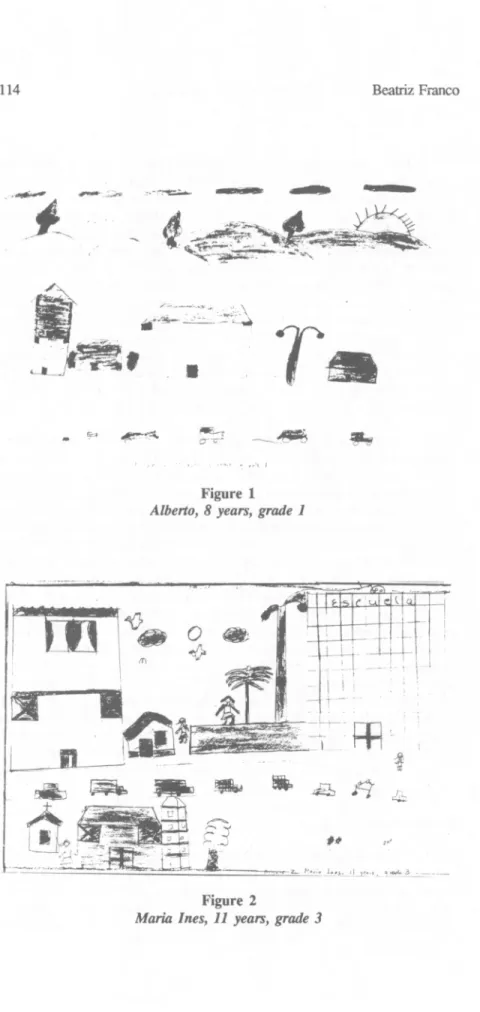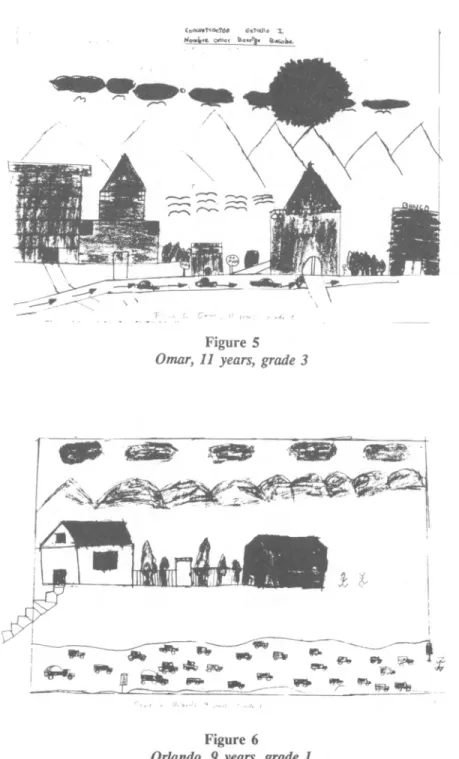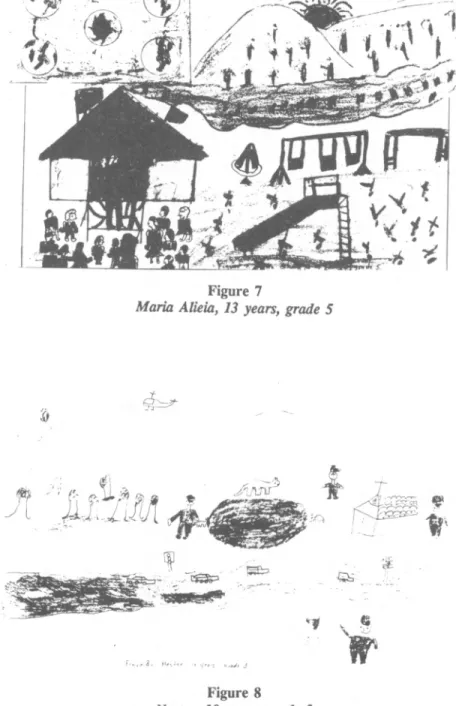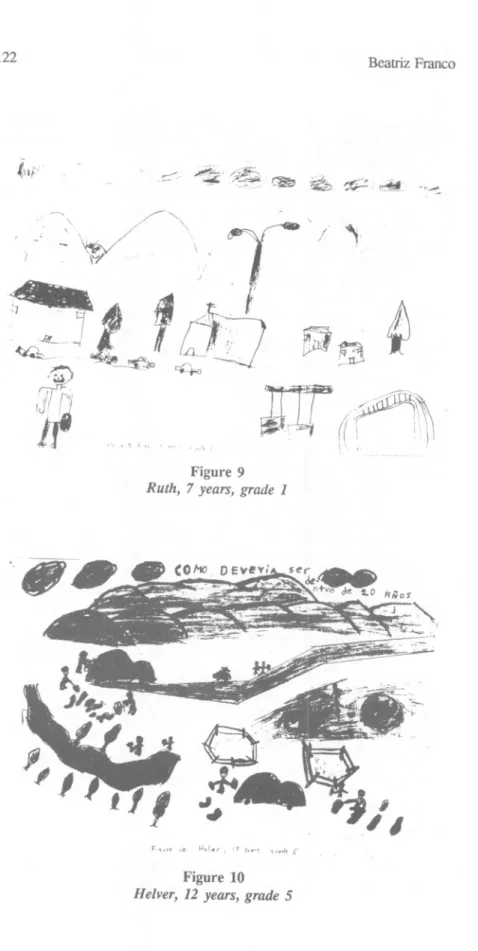Beatriz Franco
London
&Middlesex Roman Catholic School Board
(Ontario)
Colombian Children's Needs
Reflected in Drawings
Abstract
This sllmy reviews cross-cultural research regarding children's
drawings that reflect cultural values, past experiences, and the surrounding
world. In the present study, Colombian children depicted a world they are
building - a world where their basic needs are met through understanding
andcooperation.
Résumé
Cette étude fait le point sur des recherches transculturelles concernant
des dessins d'enfants qui sont le reflet de valeurs culturelles, d'expériences
vécues et du monde qui les entoure. Dans cette étude, des enfants
colombiens ont illustré un monde qu'ils se construisent, un monde où la
compréhension et
lacoopération répondent
àleurs besoins élémentaires.
Studying children's drawings and art is a very difficult task given the variety of aspects that could he analyzed. In this article, research done in Colombia with children's art shows both the striking poverty in which these children live and, at the same time, the high level of happiness and friendship they could express. A background of cross-cuItural studies in children's art is presented, folIowed by an analysis of the results of the study in Colombia.
112 Beatriz Franco
Background of research
Much has been written about early research on the relationship between children's drawings and their mental development. The literature on tests developed after the first findings is also abundant, especially on studies of the human body, houses, and trees (Harris, 1963). These tests are still used successfully, with.a computer analysis now available (Eisenberg &
Smith, 1986). More recent research has focussed on children's development of spatial slcills and/or the representation of a specific figure (Freeman, 1980; Freeman, Deregowski, Strang, Moore, & Cox, 1986; Kovoscik &
Barrett, 1985). There is also an increasing number of studies in cross-cultural differences, particularly after the frrst empirical study of this sort was published (Allen, 1983). Unfortunately, very little research bas been done on spontaneous drawings or on children's images of the future, which is the focus of the present study.
Concepts important to cross-cultural research
Drawing is a release for the emotions. When drawing, the external world is interpreted in relation to an inner mental model constructed by the children's feelings and experiences, within their immediate culture (Britton, 1982; Dennis, 1986; Wells, 1986). Cultures, however, vary greatly in their values. For example, they differ as to what is considered to be important. In a society in which the goals demand particular relations with others, the social relations are quite different from those in a competitive, aggressive society (Caughey; 1984).
Cultural differences reflect values specific to each child's culture and they appear in the drawings as soon as the scribbling stage is over (Allan, 1983). This has also been found in preschool children when drawing the human body; Japanese were more likely to draw hearts while Americans drew brains (Steward, Furuya, Steward, & Ikeda, 1982). In sorne studies, American children have been found to be aggressive, insecure, impulsive, and to have a poor self-concept while Mexicans have tended to be shy but less anxious and aggressive (Koppitz & de Moreau, 1968). These differences in attitude probably reflect different cultural values in each country. Children in Mexico appear to be more disciplined, as schools are strict, while school discipline in the United States is of a more permissive nature. Despite cultural differences between Chinese children, whose drawings reflected friendship and warmth, and Soviets, who showed more reservation and caution, their thoughts and interests appeared to be similar (Fassler, 1986). Even in the use of colours, children reflect secret behaviours and thoughts (Klepsch & Logie, 1982; Lewis & Greene, 1983), or ethnic identity and different attitudes towards their own skin colour (Young & Bagley, 1985-86).
Colombian Children's Needs Reflected in Drawings 113
Differences among children of different income families within the same culture are also significant When using dresses, low-income children in Nigeria drew African style, while middle-income children used more Western style (Pfeffer & Olowu, 1986). Sex differentiation has also been found among low-income and high-income girls in Nigeria (pfeffer, 1985). Sex difference is more or less consistent across cultures because most societies face similar life conditions and socialize for similar behaviours (Ember, 1981). The attribution of power was the most important difference between boys and girls from the United States and Israel, and again American children depicted more aggression and more sex differences than Israelis who drew aggressive themes more infrequently and showed no sex differences (Rubenstein, Feldman, Rubin, & Noveck, 1987). This last study concludes that the presence of certain characteristics as more common in one sex than the other is a fact in aU cultures, and each culture's ideology influences and refines the way sex-typing is manifested in childhood.
Concepts and findings from cross-cultural research support the premise that the depiction of the future is shaped by the present events on an individual's life (Caughey, 1984; Laissue, 1985). When drawing scenes of the past and future of their country, Jamaican students reflected very important aspects of their cultural identity. They showed an oppressive and vioient past and a future characterized by war, poverty, and crime (Gamradt, 1987). In countries affected by war or by internal conflicts, the themes of children's drawings are full of anger, hatred, death, and blood. The flag, usually drawn to express these feelings, was found in a good number of children's drawings from Northern Ireland, Nicaragua, and South Africa (Coles, 1986). Experiences lived in their country and on escaping are reflected in Indochinese children's drawings; they stressed the wish of being reunited with their families who were left behind and the fears and anguish of adapting to a new environment (Krupinski & Burrows, 1986). Cultural shock was also expressed by young Malaysian children through the representation of ecological features (Yoshikawa & Mutharayan, 1983). Such is the influence of the surrounding world and people that in a recent study the topics of a child's drawing could be identified on walks through his neighbourhood (Golom, 1987); a child with an American mother in Ponape, a very poor Asiatie island with no television, was the only child in the group to draw automobiles and a plane (Allan, 1983).
Current study
The drawings studied in this research were prepared by 7 10 13-year-old, low-income Colombian children. They reflected the children's immediate relationship with the community and the stress caused by the lack of the basic needs in the neighbourhood. This analysis follows a holistic approach that comprises the items and considers their relationship
114 Beatriz Frnnco
/~
~~Jl:;~
::'~S
T
•
, " .• ".< • ~""I ,
Figure 1 Alberto, 8 years, grade 1
Figure 2
Colombian Children's Needs Reflected in Drawings 115
to each other and to the global theme (DiLeo, 1983). It also foIlows the recommendation that children's drawings must he related not only to the experience they reflect, but also the medium in which they are done (Arnheim, 1974).
The school. The current survey was conducted in Bogotâ, early in
1986. The school, EstrelJJJ dei Sur, is one of the low-income Colombian
schools involved in an education project partIy funded by the Canadian International Development Agency (CIDA) and developed with the assistance of the University of Western Ontario (Ray, 1987). The project, started in 1984 with the participation of Colombia, Pern, and Venezuela, is related to the social studies curriculum in elementary school. The pilot units produced by teachers and students in this project have helped children to become aware of the important role they play in the preservation of the environment, and this was frequently showed in their drawings.
Estrella dei Sur functions in a very small house on the top of a hill,
south-east of the city of Bogotâ. The government provides the desks and blackboards, and appoints the teachers. The school has four classrooms, each occupied by about 40 students in each of two different shifts. Even so, there are not enough places for all the young population of the area. Holes in the wall provide ventilation and light. There are no doors, and only a few plants and posters supplied by the students decorate the rooms. The sanitary services are very rudimentary latrines, one for boys and one for girls. The places for recreation are also very restricted; students can hardly run or play. The momings are unbearably cold, but nevertheless school starts at 6:30.
The community. The neighbourhood is composed of low-income
families who started to "invade" the area fifteen years ago. They have migrated from rural areas to Bogotâ in search of work. Few of the parents have much schooling; both of them work, men usually in construction or driving buses and women as cooks or maids for medium and high-income families. It is very common to find children contributing to the family income by working several hours a day in the market place, producing goods for sale, or caring and cooking for their siblings. The corn munit y lacks a safe water supply, paved streets, telephones, electricity, and garbage collection. There is a small stream and a swamp which receive aIl the community waste. Because the government continues to do very little for the community despite po1itical pressures, everybody - including ym;ngsters and children - voluntarily attend meetings to discuss their problems and to look for possible solutions from their own resources.
Sample. A hundred and ten children in elementary school were
involved in the study: thirty-eight in frrst grade (55% girls), fort y in third (45% girls), and thirty-two in fifth (40% girls). Typical age ranges were 7-9
116
~.
Z ' Figure 3 .
oraida Eloisa 12
,
years, grade 5
c.,,.." ,...(!, -'~,..
1 r ~ 1 '" C ..
Figure 4
Jose Moises 12
,
years, grade 5
r - -Beatriz Franco . _
..
,. ~..
~ ~ -r~-'" t L . . _Colombian Children's Needs Reflected in Drawings 117
for grade one, 9-11 for grade thre.e, and 11-13 for grade five. The students were asked to make a drawing answering the question: "How do you think the world should be in twenty years"? The drawings were executed at the same time by all the students within a time limit of one hour.
Results
The drawings were in general weIl distributed on the whole page, organized and full of colour. A shining sun, blue sky and clouds, mountains and houses was the overall picture (see Table 1). Among younger children, these features appeared bigger and in a stereotyped form. The mountains and houses occupied the largest portion of the paper. Houses were very simple structures drawn with straight lines, usually indicating two windows and a door. The school and the church were drawn by a significant number of third graders (62% and 55%, respectively), compared with the frequency drawn by children in the other two grades. The school was often presented as a nice, big building, usually more than three stories tall. Very tall buildings, drawn mostly by older children, were usually banks and hotels. The size of natural features and houses did not decrease much with age, but more attention to details was corn mon in older children. Houses, for example, presented a more complex and varied structure.
Human figures were segregated, smaIl, and in a stick-like fonn among younger children. Almost half of third graders also presented this kind of figure, the other half drew their own selves, evidenced in hair style or clothing. Fifth graders' human figures were more numerous, very elaborated and with distinguishable body parts. They were often smiling and gathered 1Ogether. Boys drew mostly their own sex while girls drew both sexes.
Particularly notable in the three grades was the depiction of streets (86%) and electrical facilities (60%). First graders drew often only one curved or straight street of any colour; sorne of the children included cars and a good number (74%) oftraffic lights. Third graders presented morethan one street; they were mostly straight and black with more cars and busses but fewer traffic lights. Fifth graders drew two or three carefully straight black streets with cars and buses, and people inside. Electric poles were fewer and simpler in drawings by younger children; sorne of them showed a wire coming directly from the pole 10 a house. Older children drew several more elaborated poles along the streets, connected 10 each other.
Among fifth graders two items were significantly more often portrayed: a river or a swamp, usually with fishes or ducks, and surrounded by vegetation, and the garbage collection represented mostly by the truck collector. Playgrounds appeared infrequently, and were usually full of
118
•
<orwRfl'CQc:T6. é."~\o ~ "" .... 1,(.
.. otn.( "0.,.)- "4160 ... . . Figure 5Omar,l1 years, grade 3
:J, .. ~.;. " , .... : ,",l, 1
Figure 6
Orlando,
9
years, grade 1Colombian Children's Needs Reflected in Drawings 119
Table 1
Characteristics of each group as a percentage of the total for that group
Ist 3rd 5th Mountains 81.5 37.5 43.7 Clouds 84.2 95.0 78.1 Sun 73.6 92.1 75.0 Houses 100.0 100.0 100.0 Sehool 7.8 62.5 15.6 Chureh 18.4 55.0 28.1 Tall buildings 13.1 44.7 46.8 Streets 86.8 90.0 81.2 Traffie lights 60.5 22.5 6.2 Electricity 73.6 52.5 53.1 Animals 28.9 22.5 34.3 People 63.1 67.5 90.6 Playgrounds 23.6 30.0 28.1 River/Swamp 5.2 17.5 50.0 Garbage collection 2.5 7.5 65.6
n = 38 (grade 1), 40 (grade 3), 32 (grade 5)
children; most of the older boys included figures playing soccer. Animals (usually dogs, cats, and birds) appeared in a small percentage. There were three other figures not shown in the table because of the small percentage: the Colombian flag (10%), planes (8.2%), and television antennae (4.5%) in the overall content. (See Figures 1, 2, and 3 for an example of the progression in each one of the three grades.)
Conclusions
The findings presented here are the reflection of the worries and wishes of a deprived group of children. It is obvious that the ideology of this particular group of people has a great influence in the young population of the area. Although most of these children go through life experiencing aIl sorts of adult situations and very little "normal" childhood, the drawings showed them as warm, extroverted, optimistic, and cooperative. The world for them is their immediate environment, with very little influence of the television or the modemity of the big capital city. They have adjusted the present to bring changes such as bigger and better schools and houses, paved streets with signs and traffic lights (Figures 2, 3, 4, 5) or parks and
120
Figure 7
Maria Alieia, 13 yean, grade 5
Figure 8
Neswr, 10 years, grade 3
Beatriz Franco
~
._-Colombian Children's Needs Reflected in Drawings 121
playgrounds (Figures 4, 7, 9). The future world is viewed with optimism -neither violent nor oppressive - with some material progress, but a world where natural beauty remains (Figures 7,8).
The fact that children draw important things frrst and large is true here, but the repetition of certain figures (e.g., streets, electrical fixtures, traffic lights) even in a small size is probably a sign of the value the children place on these items. The number of houses (100%) at alileveis is not surprising, given that this is one of the things children draw flfst and like drawing. The repetition of mountains and clouds is a reflection of the view from the top of the hill these children live on. The large number of traffic lights among first graders (Figures 1, 6, 9) could be related to their recent experience of one of their classmates being killed by a car. Streets and electricity were a main concern of aIl ages. Older children were also worried about environmental issues, like clean water and garbage collection. They also introduced the need for cooperation by drawing people gathered and working together (Figures 7,8, 10).
The idea that drawings of their own sex decline as children approach adolescence was true for only fifth grade girls; boys still tended to draw their own sex. Aggression, which has been a theme found generally in boys' drawings more than in girls', was not true here. Neither boys nor girls depicted signs of aggression. Policemen were portrayed as friendly helpers more than punishers (Figures 8, 10). Religious values were also evidem, especially among third graders; the church was usually the form of representation. The larger number of churches and schools among this group (Figures 2, 5) represents the importance they give to them, as those
are
the places where the community gathers, and at the time of the survey some of these children had started to attend the meetings.When comparing the findings in this study to those reviewed in the literature, one can assume that this particular group of children, like Mexican, Chinese, and Japanese, tend to be friendly, warm and not aggressive. Unlike Jamaicans, Colombians' vision of the future is full of hope and progress. Despite the conflicts they
are
exposed to through their contact with adults, these Colombian children did not show in their drawings any signs of anger or hatred towards the government or the institutions. Unlike most children, Colombians did not represent most objects as they had seen or experienced them, but as they wanted them to be.Implications of this study
When children draw, they escape the frustrations imposed by language, procedures, or attention to prescribed details. Children depict what
122 Beatriz Franco
Figure 9
Ruth, 7 years, grade 1
Figure 10
Colombian Children's Needs Reflected in Drawings
123
they fmd important The problems of intetpretation of their work remain substantial but have been reduced by examining the research done in several other studies. It is evident that interpretation cao become fairly objective.
The style and content of these drawings reflect an optimism that sorne adult Colombians might dispute. The children's expectations
are
modest but probably capable of heing realized. If a similar study had been conducted in a high-income school in Bogotâ, the visions of these chilc:lren would have reflected different anxieties and needs.For
them, material needs are quicldy satisfied, and their nice neighbourhoods and schools have all the commodities. They would have probably portrayed a similar sunny future world, but full of material advantages. In this, the study reflects social classas
muchas
national origin. However, the apparently common interests of young children may he one of the most important findings.REFERENCES
Allan, A. (1983). Playing with form. Children draw in six cuIJures. New York: Columbia University Press.
Arnheim, R. (1974). Art and visual perception: The new version. Berkeley:
University of California Press.
Brinon, 1 (1982). The role of fantasy. In OM. Pradl (Editor), Prospect and
retrospect. Se/ected essays (pp. 37-45). Montclair, NI: BoytoniCook
Publishers, Inc.
Caughey, 1.L. (1984). lmaginary social worlds. Lincoln, NE: University of
Nebraska Press.
Coles, R. (1986). The political life of children. New York: The Atlantic
Monthly Press.
Dennis, W. (1966). Group values through children's drawings; New York: Wiley.
DiLeo, NJ. (1983). Interpreting children's drawings. New York:
Brunner/Mazel.
Eisenberg, lM., & Smith, I l (1986). The projective drawing tests:
Computer analysis - School version. Software Review Section,
JOUI'MI of School Psychology, 24(2), 1.
Ember, CR (1981). A cross-cultural perspective on sex differences. In RH.
MlD'II'oe, R.L. Monroe and BB. Whiting (EditQrs), Handbook of
cross-cultural human development (pp. 531-580). New York: Oarland STPM
Press.
Fassler, 0.0. (1986). Children's drawings from China and the Soviet Union.
Childhood Education, 63(1), 31-38.
Freeman, NB. (1980). Strategies of representation in young children. London: Academic Press.
Freeman, N.H., Deregowski, lB., Strange, P., Moore, V., & Cox, M.V.
(1986). Children's drawings of cubes. (Special Issue) British JOU1'7llJI
124
Beatriz Franco
Garnradt, J.A. (1987, November). Proxirnity ta taurism, schooling, and the
historica1 and anticipatory imagery of Jamaican school children. Paper presented at the American Educational Studies Association Annual Convention. Chicago, ILL.
Golom, C. (1987, April). Reflections on cultural variables and universals in
young children's drawings. Paper presented at the Biennial Meeting of
the Society for Research on Child Development, Baltimore, MD.
Harris, D.H. (1963). Children's drawings as measures of intellectual maturity. New York: Harcourt, Brace & World, Inc.
Koppitz, E.M., & de Moreau, M.A. (1986). A comparison of emotional
indicators of human figure drawings of children from Mexico and from the U.S. Revista Interamerieana de Psieolog/a, 2, 41-48.
Koroscik, 1., & Barrett, T. (1985, April). Arts and Leaming SIG. Proceedings
of the Annual Meeting of the American Educational Research Association. Chicago, IlL.
Klepsch, M., & Logie, L. (1982). Children draw and tell. New York:
Brunner/Mazel, Inc ..
Krupinski, 1., & Burrows, G. (1986). The priee of freedom. Sydney: Pergamon Press.
Laissue, J. (1985). Private visions, public features: A cultural study of students' images of the future. Unpublished doctoral thesis, University of Maryland.
Lewis, D., & Greene, 1. (1983). Your child's drawings ... their hidden
meaning. London: Hutchison.
Pfeffer, K. (1985). Sex-identification and sex-typing in sorne Nigerian
children's drawings. Social Behavior and Personality, /3(1), 69-72.
Pfeffer, K., & Olowu, A.A. (1986). Perception of dress style in sorne Nigerian
children's drawings. The Journal of Social Psychology, 126(3), 287-90.
Ray, D.W. (1987). Evaluating international curriculum development:
Cooperation and self-reliance in the social studies of Peru, Colombia
and Venezuela. ERIC ED 284 807.
Rubenstein, 1., Feldman, SJ., Rubin, C., & Noveck, 1. (1987). A
cross-cultural comparison of children's drawings of same- and mixed-sex peer interaction. Journal of Cross-Cultural Psychology, 18(2), 234-250.
Steward, M.S., Furuya, T., Steward, D.S., & Ikeda, A. (1982). Japanese and
American children's drawings of outside and inside of their bodies.
Journal of Cross-Cultural Psychology, /3(1), 87-104.
Wells, G. (1986). The meaning rnakers. Portsmouth, NH: Heinemann
Educational Books, Inc.
Yoshikawa, K., & Mutharayan, L. (1983, May). Cross-cultural study of
cognitive development of Malaysian children using the tree-drawing test. Paper presented at the Regional Conference of IACCP. Kuala Lumpur, National University.
Young L., & Bagley, C. (1986). Identity, self-esteem and evaluation of colour
and ethnicity in young children in Jamaica, Ghana, England and Canada. Journal of the Canadian Association for Young Children, 10(1),51-68.
Colombian Children's Needs Reflected in Drawings



